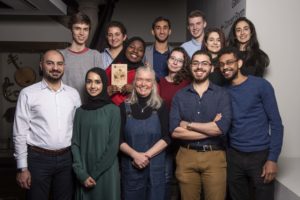Cultivating a greener Future: introducing our new Forest and Peatland Manager

An introduction from David Bruce on his new role as Forest and Peatland Manager for the University of Edinburgh’s programme to sequester carbon through forest and peatland restoration in Scotland.
I’m excited to step into this exciting role to restore and enhance Scotland’s natural landscapes. We’re planting trees on University-owned sites (Rullion Green Wood, Drumbrae, and Barvick Burn Wood), while also collaborating with partners across Scotland to restore damaged peatlands and expand woodland cover.
A vision for restoration
Our University has embarked on an ambitious plan to create thriving woodland ecosystems across land that we own in Scotland. This project is not just about planting trees; it’s about enhancing biodiversity, combating climate change, and improving the ecological health of our landscapes. As the Forest and Peatland Manager, my role is to ensure these projects are effectively planned and executed, bringing benefits to local areas both socially and environmentally.
Aims and objectives
The primary aim of our woodland creation projects is to capture atmospheric carbon whilst delivering resilient ecosystems that support a wide variety of plants and animals. By focusing on creating mixed woodland, we will create habitats that celebrate Scotland’s rich natural heritage.
Our objectives include:
- Biodiversity enhancement: By introducing diverse plant species, we aim to support wildlife populations and promote ecological interactions. This diversity is crucial for building resilient ecosystems capable of withstanding environmental changes.
- Carbon sequestration: Forests play a vital role in capturing carbon dioxide from the atmosphere. Our projects are designed to maximise this potential, contributing to the University’s commitment to reducing its carbon footprint.
- Community engagement: Engaging with students, local residents, and stakeholders is central to our mission. Through workshops, volunteer opportunities, and educational programmes, we aim to inspire collective stewardship of our natural spaces.
- Research and education: These sites will serve as living laboratories for research into sustainable forestry practices, climate resilience, and conservation strategies. We aim to integrate academic inquiry with practical implementation, offering rich learning experiences for our students.
- Restoration of peatlands: Beyond woodlands, our focus extends to restoring peatlands, which are incredible carbon sinks and vital for water regulation. Restoring these areas helps protect unique ecosystems and further contribute to our sustainability goals.
My journey in nature restoration
I started working in forestry and nature restoration over 20 years ago, driven by my passion for woodland management and conservation. Through managing projects in diverse landscapes, I’ve witnessed first-hand the profound impact that restoration can have on revitalising ecosystems.
Throughout my career, I’ve worked on a range of projects, including expanding native woodlands, restoring peatlands in the Flow Country, conserving ancient woodlands, and managing habitats to protect native species like capercaillie, black grouse, Atlantic salmon and freshwater pearl mussels.
I feel lucky to have chosen a career where I can make a positive impact on landscapes and contribute to lasting benefits for biodiversity and the climate.
The range of projects I have been involved with across Scotland has reinforced my belief in the power of nature to recover and provide wide-ranging benefits for both ecosystems and society. In the context of the Forest and Peatland programme at the University, I am particularly excited to see the developments in community involvement in the environmental work we’re doing on our three sites in Scotland.
The road ahead
As I step into this role, I know we need to utilise the University’s wealth of knowledge and expertise to achieve our restoration goals. Collaboration is at the heart of our projects, and I am eager to work with the talented teams at the University, our partners, and the local communities.
We’re on an exciting, long-term path towards creating landscapes that not only enhance biodiversity but bring multiple benefits: University teaching and research, local communities and carbon sequestration to name a few. I look forward to sharing our progress and invite you to consider how your area of work may overlap with the programme, and to reach out to me and the team to learn more.





Recent comments